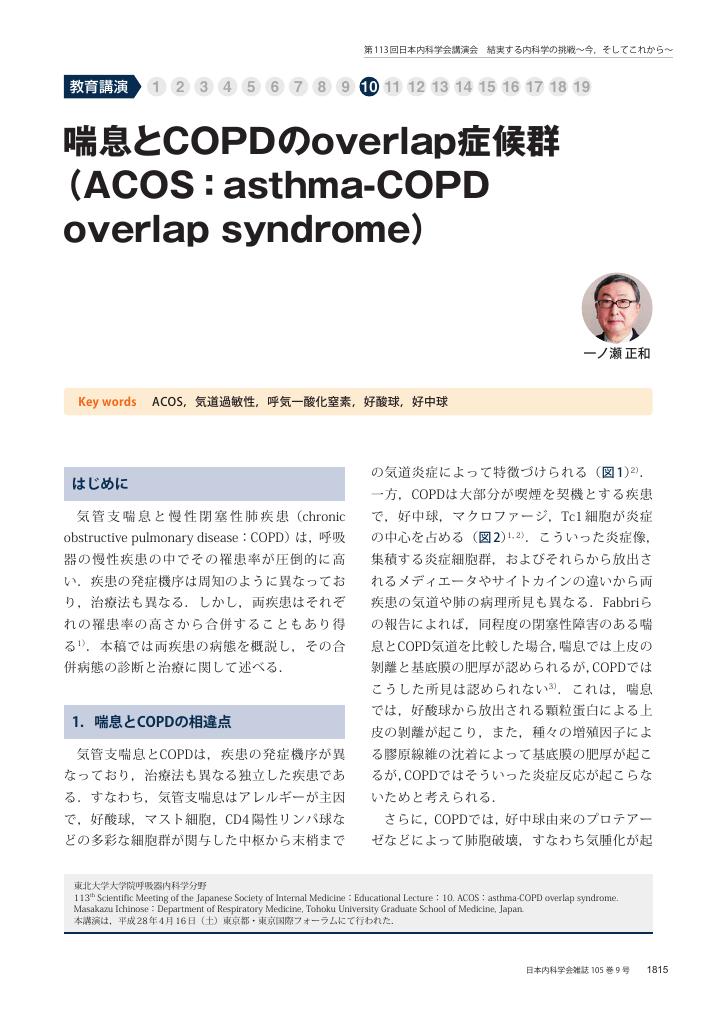6 0 0 0 OA 2.バイオマーカー測定の意義と限界
- 著者
- 一ノ瀬 正和
- 出版者
- 一般社団法人 日本内科学会
- 雑誌
- 日本内科学会雑誌 (ISSN:00215384)
- 巻号頁・発行日
- vol.98, no.12, pp.3026-3032, 2009 (Released:2012-08-02)
- 参考文献数
- 14
- 被引用文献数
- 1
気管支喘息の診断及び管理において,スパイロメトリーによる閉塞性障害の評価や気道過敏性検査がこれまで行われてきた.一方,喘息の本態である「気道炎症」に関しても,喀痰,呼気ガス,呼気凝縮液といった検体を用いた方法が臨床応用されつつある.これら所謂「バイオマーカー」の中でも呼気一酸化窒素濃度測定は非侵襲的で発作期にも行えることから,今後のさらなる展開が期待される.
5 0 0 0 OA VII.呼吸器疾患と脳神経障害
- 著者
- 松永 和人 一ノ瀬 正和
- 出版者
- 一般社団法人 日本内科学会
- 雑誌
- 日本内科学会雑誌 (ISSN:00215384)
- 巻号頁・発行日
- vol.101, no.8, pp.2219-2225, 2012 (Released:2013-08-10)
- 参考文献数
- 7
呼吸器系は,肺,胸壁,肺循環,中枢神経系から構成される.呼吸中枢は,肺胞のガス交換である換気を調節する.換気障害は,中枢神経の呼吸ドライブ,呼吸神経筋,肺換気の障害により生じ,低酸素血症を伴う高二酸化炭素血症の原因となる.最近,増加している睡眠時無呼吸症候群は,心血管・脳血管の障害や糖尿病と深く関連する.さらに,Churg-Strauss症候群は呼吸器と脳神経を系統的に障害する血管炎症候群として重要である.
ヒスタミンH3受容体は、中枢ヒスタミン神経系のシナプス前部に存在するオートレセプターで、ヒスタミンの遊離、合成を調節している。最近、末梢にも、また、他の神経系にも存在するといわれている。本研究では、ヒスタミンと関連する病態として喘息と痴呆をとりあげ、H3リガンドのこれらの疾患モデル動物での効果を検討した。まづ、老化促進モデルマウスを用いて、シャトルボックス法で学習・記憶能を評価した。異常老化系(P/8)は、正常老化系(R/1)に比して、学習獲得が遅かったが、H3アンタゴニスト、チオペラミドの投与で、R/1マウスと同じレベルまで改善した。しかし、R/1マウスの学習能が更によくなることはなかった。スコポラミン投与によりアセチルコリン系を障害した痴呆モデル・マウスにおいても、elevated plus maze testで評価したところ、チオペラミド投与が改善を示した。種々の喘息モデルに対するH3作動薬(R)-α-メチルヒスタミン、イミテットの効果を検討したが、明確な効果は得られなかった。より適したモデル系の確立が必要である。新規H3アンタゴニスト、AQ0145(ミドリ十字社)は、マウスの電撃痙攣に対する抑制作用においてチオペラミドとほぼ同程度であった。6-ヒドロキシドパミンをラットの片側線条体に注入する除神経において、障害側の線条体と黒質ではヒスタミンH3受容体の密度は上昇した。この上昇は、ドパミンD1アゴニスト、SKF38393処置で対側レベルまで低下したが、D2アゴニスト、キンピロールは影響しなかった。即ち、ドパミン神経系の障害に伴う神経可塑性において、D1受容体を介してヒスタミンH3受容体のアップ・レギュレーションが制御されていることが判明した。チオペラミド、(R)αメチルヒスタミンのラットにおける体内動態を検討したが、いずれも脳への移行性がわるいことが判明した。本研究の過程で、H3アンタゴニストに抗痙攣作用が有ることが判明し、今後に期待を抱かせた。結論として、H3アンタゴニストは、てんかん、痴呆の薬物となりうることが示された。そのためには、なお一層の基礎的知見の集積が必要である。
2 0 0 0 OA 1.呼吸機能検査
- 著者
- 一ノ瀬 正和
- 出版者
- 一般社団法人 日本内科学会
- 雑誌
- 日本内科学会雑誌 (ISSN:00215384)
- 巻号頁・発行日
- vol.97, no.6, pp.1206-1213, 2008 (Released:2012-08-02)
- 参考文献数
- 9
COPD患者は咳,痰,労作時息切れなどの症状があっても,加齢現象と考えてあまり訴えないので,医師が積極的にスパイロメトリーを行い,早期にCOPDを見出す姿勢が大切である.気管支拡張薬吸入後の一秒率が70%未満で他の閉塞性疾患(喘息,気管支拡張症等)を否定することでCOPDの診断ができる.補助検査として,胸部写真やCTといった画像に加え,肺拡散能検査が有用である.
- 著者
- 一ノ瀬 正和
- 出版者
- 一般社団法人 日本内科学会
- 雑誌
- 日本内科学会雑誌 (ISSN:00215384)
- 巻号頁・発行日
- vol.105, no.9, pp.1815-1819, 2016-09-10 (Released:2017-09-10)
- 参考文献数
- 11
2 0 0 0 OA 気管支喘息と自律神経機能障害
- 著者
- 一ノ瀬 正和
- 出版者
- 公益社団法人 日本薬理学会
- 雑誌
- 日本薬理学雑誌 (ISSN:00155691)
- 巻号頁・発行日
- vol.111, no.4, pp.195-203, 1998 (Released:2007-01-30)
- 参考文献数
- 37
- 被引用文献数
- 6 4
Airways are richly innervated by 4 nervous systems: adrenergic, cholinergic, inhibitory nonadrenergic noncholinergic (i-NANC), and excitatory NANC (e-NANC) nervous systems. Dysfunction or hyperfunction of these systems may be involved in the inflammation or airway hyperresponsiveness observed in asthmatic patients. The cholinergic nervous system is the predominant neural bronchoconstrictor pathway in humans. Airway inflammation results in exaggerated acetylcholine release from cholinergic nerves via dysfunction of the autoreceptor, muscarinic M2, which is possibly caused by a major basic protein or IgE. Vasoactive intestinal peptide (VIP) and nitric oxide (NO) released from i-NANC nerves act as an airway smooth muscle dilator. The effects of VIP and NO are diminished after allergic reaction by inflammatory cell-mediated tryptase and reactive oxygen species. Thus, in asthmatic airways, the inflammatory change-mediated neural imbalance may result in airway hyperresponsiveness. Tachykinins derived from e-NANC nerves have a variety of actions including airway smooth muscle contraction, mucus secretion, vascular leakage, and neutrophil attachment; and they may be involved in the pathogenesis of asthma. Since tachykinin receptor antagonists are effective for bradykinin- and exercise-inducedbronchoconstriction in asthmatic patients, these drugs may be useful for asthma therapy.
1 0 0 0 OA COPD(慢性閉塞性肺疾患)診断と治療のためのガイドライン2018
- 著者
- 一ノ瀬 正和
- 出版者
- 一般社団法人 日本内科学会
- 雑誌
- 日本内科学会雑誌 (ISSN:00215384)
- 巻号頁・発行日
- vol.107, no.11, pp.2306-2309, 2018-11-10 (Released:2019-11-10)
- 参考文献数
- 1
1 0 0 0 OA 気道過敏性における最近の知見
- 著者
- 一ノ瀬 正和
- 出版者
- 一般社団法人 日本内科学会
- 雑誌
- 日本内科学会雑誌 (ISSN:00215384)
- 巻号頁・発行日
- vol.93, no.4, pp.794-799, 2004-04-10 (Released:2008-06-12)
- 参考文献数
- 20
気道過敏性の亢進とは,わずかな刺激物質の吸入で,気道狭窄をきたすことで,気管支喘息の重要な病態の一つである.この亢進には気道平滑筋,自律神経系,気道上皮,微小血管,炎症細胞等多彩な細胞群が関与しており,それぞれの制御が喘息治療に繁がる.慢性閉塞性肺疾患(COPD)でも気道過敏性亢進が認められるが,これは予め気道が狭窄しているという物理学的因子によるもので喘息とは機序が異なる.
1 0 0 0 OA 発熱,多関節痛を伴った急性サルコイドーシスの1例
- 著者
- 小野寺 克洋 玉田 勉 村松 聡士 村上 康司 奈良 正之 小松 理世 小林 誠 山田 充啓 杉浦 久敏 一ノ瀬 正和
- 出版者
- 一般社団法人 日本内科学会
- 雑誌
- 日本内科学会雑誌 (ISSN:00215384)
- 巻号頁・発行日
- vol.105, no.3, pp.540-546, 2016-03-10 (Released:2017-03-10)
- 参考文献数
- 8
38歳,女性.多関節痛を自覚後,急速にぶどう膜炎,発熱,咳嗽,体重減少,肺門リンパ節腫脹などを認め,気管支鏡検査,ガリウムシンチなどでサルコイドーシスと診断した.急性サルコイドーシスのLöfgren症候群のうち結節性紅斑を伴わないvariant formが考えられた.全身ステロイド治療を開始し症状は速やかに改善した.本症候群は本邦で稀であり,全身症状の強いサルコイドーシスでは鑑別に挙げる必要がある.
1 0 0 0 OA 見逃されやすい呼吸器疾患とその対策
- 著者
- 一ノ瀬 正和 永井 明日香 菊地 利明 杉山 幸比古
- 出版者
- 一般社団法人 日本内科学会
- 雑誌
- 日本内科学会雑誌 (ISSN:00215384)
- 巻号頁・発行日
- vol.105, no.6, pp.1004-1015, 2016-06-10 (Released:2017-06-10)


